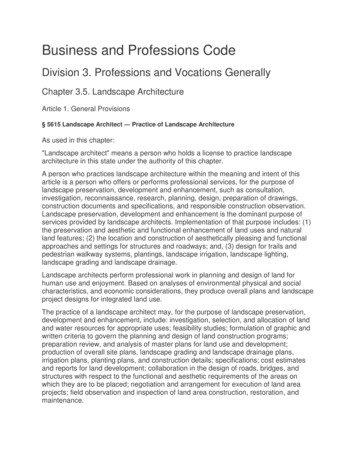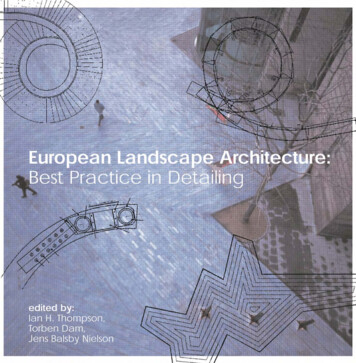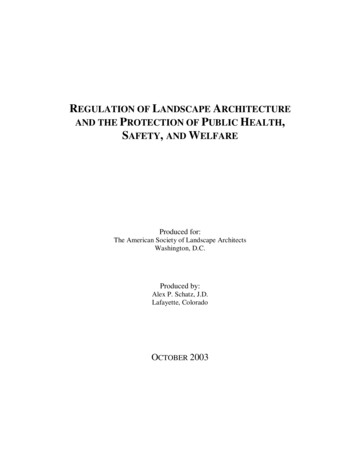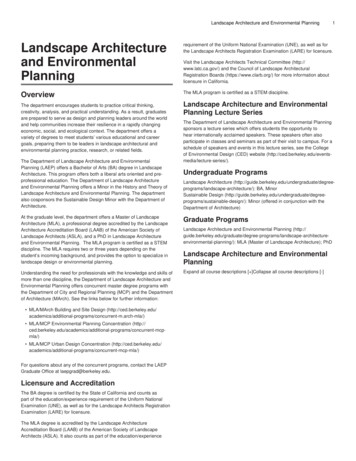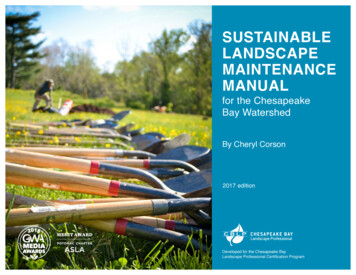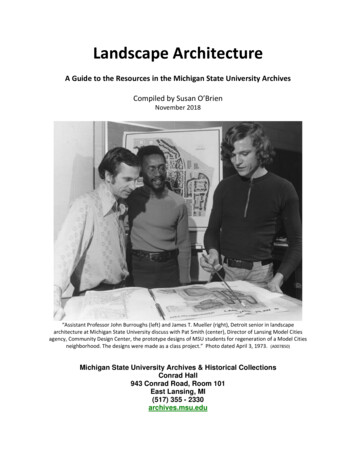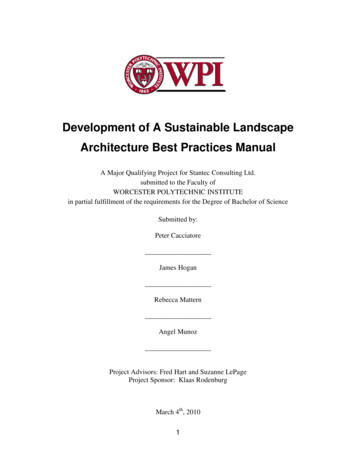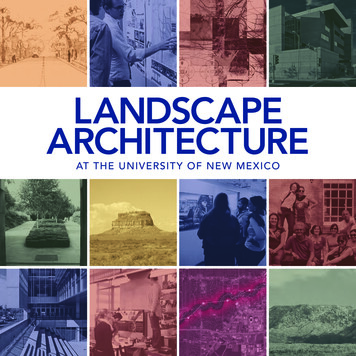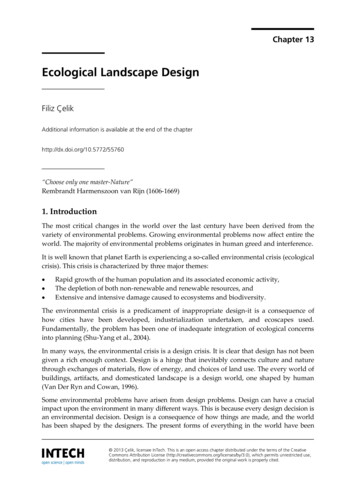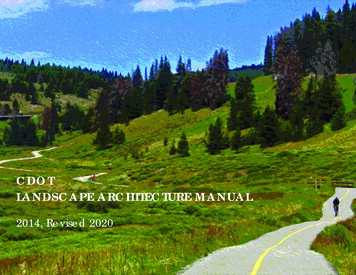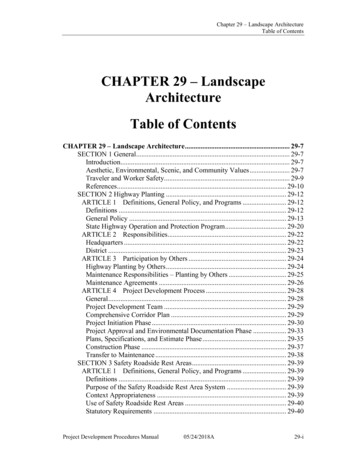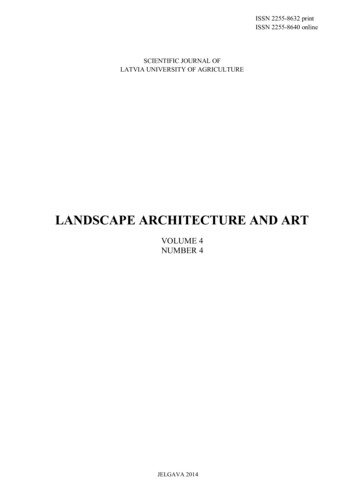
Transcription
Scientific Journal of Latvia University of AgricultureLandscape Architecture and Art, Volume 4, Number 4ISSN 2255-8632 printISSN 2255-8640 onlineSCIENTIFIC JOURNAL OFLATVIA UNIVERSITY OF AGRICULTURELANDSCAPE ARCHITECTURE AND ARTVOLUME 4NUMBER 4JELGAVA 2014
Scientific Journal of Latvia University of AgricultureLandscape Architecture and Art, Volume 4, Number 4EDITOR IN CHIEFAija Ziemeļniece, Dr. arch., Professor, Latvia University of Agriculture, Jelgava, LatviaEDITORIAL BOARDUģis Bratuškins, Dr. arch., Professor, Riga Technical University, Riga, LatviaMaria Ignatieva, Dr. phil., Professor, Swedish University of Agricultural Sciences,Uppsala, SwedenKarsten Jorgensen, Dr. scient., Professor, Norwegian University of Life Sciences,Oslo, NorwayJānis Krastiņš, Dr. habil. arch., Professor, Riga Technical University, Riga, LatviaJuhan Maiste, Dr. art., Professor, University of Tartu, Tartu, EstoniaEglė Navickienė, Dr. arch., Assoc. Professor, Vilnius Gediminas Technical University,Vilnius, LithuaniaValeriy Nefedov, Dr. arch., Professor, St. Petersburg State University of Architecture andCivil Engineering, St. Petersburg, RussiaThomas Oyen, Professor, Neubrandenburg University of Applied Sciences,Neubrandenburg, GermanyGintaras Stauskis, PhD arch., Assoc. Professor, Vilnius Gediminas Technical University,Vilnius, LithuaniaIvars Strautmanis, Dr. habil. arch., Professor, Riga Technical University, Riga, LatviaOjārs Spārītis, Dr. habil. art., Professor, Art Academy of Latvia, Riga, LatviaSandra Treija, Dr. arch., Assoc. Professor, Riga Technical University, Riga, LatviaDaiga Zigmunde, Dr. arch., Latvia Univeristy of Agriculture, Jelgava, LatviaSECRETARY AND LAYOUT DESIGNERUna Īle, Dr. arch., Latvia University of Agriculture, Jelgava, LatviaADDRESS OF THE EDITORIAL BOARDFaculty of Rural EngineersLatvia University of Agriculture19 Akademijas iela, Jelgava, Latvia, LV–3001Fax: 371 63021397Phone: 371 29185575E–mail: una.ile@llu.lvAbstracted and indexed*AGRIS; CABI PUBLISHING CAB ABSTRACTS; EBSCO Art Source(*) – Attention! The data bases select the articles from the proceedings for including them in their data basesafter individual qualitative examination. All scientific paper was reviewed by two independent reviewers.Every author is responsible for the quality and the information of his article.Read our scientific juornal in: http://llufb.llu.lv/Raksti/Landscape Architecture Art/ LATVIA UNIVERSITY OF AGRICULTURE, 20142
Scientific Journal of Latvia University of AgricultureLandscape Architecture and Art, Volume 4, Number 4INTRODUCTIONPRIEKŠVĀRDSIn the scientific journal Landscape Architectureand Art of the Latvian University of Agriculture(LUA), where so far, mostly, the findings of thetheoretical studies of the landscape space inLatvia have been compiled, the results of internationalstudies appear more and more.The articles analyse the quality of the environment,ecological issues, the contemporary art and itsinteraction trends in the Latvian cultural landscape, andthe theoretical and practical perspective of thelandscape design. The studies show that a morebalanced sectoral cooperation of specialists and a morecomplete landscape planning and development strategyshould be searched in carrying out in-depth studies inseveral directions and in evaluating the landscapearchitect‟s role as a mediator in the landscape planningprocesses. The level of the current theoreticalunderstanding, the mutual cultural landscapeand the contemporary art interaction is not enoughevaluated by specialists. In the process of creatingthe cultural landscape, a multidisciplinary collaborationof specialists is missing.The studies show that landscape architectureprojects should include the accumulated experienceof artists, reading the landscape as a piece of art andsearching for the synthesis, where the elementsof the landscape space become like pieces of art.One of the major Latvian cultural and historicalpremises is the landscape surrounding thearchaeological monument that is closely relatedto the landscape elements in the surroundingsof the archaeological monuments.Along with the foreign scientists, a new andcomprehensive study has been started on theLatvian road landscape development, reflecting theevents of the history, changes in the national politics,economy, changes in the structure of land ownershipand use. The results of the study call attention to thefact that in the development of the new roadinfrastructure, picturesque view lines, telling about thecultural and historical landscapes, are gradually beinglost. It also applies to the opportunities for thedevelopment of tourism infrastructure in Latvia.“The practical activities in the creation of thelandscape space are not feasible without a sciencebased theoretical framework, so the findings, publishedin the collection, can be useful for architects, urbanplanning professionals and the authorities responsiblefor the conservation and protection of our heritage.It is brightly illustrated by the doctoral theses defendedthis year, says Agate Eniľa ”Architecture of Buildingsof the Arts in Latvia” (Riga Technical University),MadaraMarkova”TheChurchlandscapeof Latgale”and Natalija Nitavska ”The Identity oflandscape of Baltic sea coast Latvia” (LUA).Latvijas Lauksaimniecības universitātes (LLU)zinātniskais ţurnāls Landscape Architecture and Art,kurā līdz šim, galvenokārt, apspoguļojās Latvijasainavtelpas teorētiskie pētījumi, aizvien plašāk tiekapkopoti starptautisko pētījumu loģijas jautājumu problemātika, kā arī mūsdienumākslas un tās mijiedarbības tendences Latvijaskultūrainavā, un ainavu veidošanas teorētiskais unpraktiskais skatījums.Pētījumi parāda, ka ir jāmeklē daudz �gākaainavas plānošanas un veidošanas stratēģija,veicot padziļinātākus pētījumus vairākos virzienos,un izvērtējot ainavu arhitekta – kā mediatora lomuainavu plānošanas procesos. Līdzšinējais teorētiskāsizpratnes un savstarpējais kultūrainavas un mūsdienumākslas mijiedarbības līmenis nav pietiekami ievērtētsspeciālistu vidū. Patreizējā kultūrainavas veidošanasprocesā iztrūkst daudznozaru speciālistu sadarbība.Pētījumi liecina, ka ainavu arhitektūras projektosjāiekļauj mākslinieku uzkrāto pieredzi, skatot ainavu kāmākslas darbu un meklējot sintēzi, kur ainavtelpaselementi pastāv kā mākslas darbi.Viena no svarīgām Latvijas kultūrvēsturiskajāmtelpām ir arheoloģijas pieminekļu aptverošās ainavas,kas ir cieši saistītas ar ainavas elementiem arheoloģijaspieminekļu apkārtnē.Kopā ar ārvalstu zinātniekiem ir aizsākusiesiestrāde jaunam un plašam pētījumam parLatvijas autoceļu ainavu, kurā atspoguļojas vēsturesnotikumi, pārmaiľas valsts politikā, ekonomikā,izmaiľas zemes īpašumu struktūrā un izmantošanasveidā. Pētījuma rezultāti liek saasināti pievērstuzmanību tam, ka jaunas ceļu infrastruktūras izveidēpamazām tiek zaudētas gleznainas skatu līnijas,kas vēsta par kultūrvēsturiskajām ainavtelpām unreģionam raksturīgo identitāti. Reizē tas ir attiecināmsuz tūrisma infrastruktūras attīstības iespējām Latvijā.Praktiskā darbība ainavtelpas izveidē navīstenojama bez zinātniski pamatotas teorētiskās bāzes,tāpēc krājumā publicētais var noderēt profesionālajādarbā gan arhitektiem, gan pilsētplānošanasspeciālistiem, gan par kultūras mantojuma saglabāšanuun aizsardzību atbildīgajām institūcijām.Spilgti to apliecina šogad aizstāvētie promocijasdarbi – Agate Eniľa „Mākslu ēku arhitektūra Latvijā”(RTU), Madara Markova „Latgales dievnamuainava”(LLU) un Natālija Ľitavska ”Baltijas jūraspiekrastes ainavu identitāte Latvijā” (LLU).Aija ZiemeļnieceEditor in Chief3
Scientific Journal of Latvia University of AgricultureLandscape Architecture and Art, Volume 4, Number 4CONTENTSMāra UrtāneArchaeological site – environmental element .5Kristīne Vugule, Simon Bell, Ilze StokmaneRoad landscape development in Latvia up to the 21st century . 10Linda Balode, Aija GrietēnaHarmony of Rehabilitation Garden, Architecture and Interiors in the Brukna ManorComplex after the Functional Transformation in the 21st Century . 17Indra Purs, Evita AlleNatural Elements and Phenomena of the Atmospherescapeas a Material for Public Art . 32Evita AlleContemporary Art in Cultural Landscape: Experience and Opinions . 49Anna GančorovaEnergy efficiency in the development of landscape space . 57Aija ZiemeļnieceTransformation of the landscape space in the post-war years Jelgava example . 67Jānis ZilgalvisBurtnieki Rectory - a symbol of the cultural-historicalenvironment unaltered through time . 764
Scientific Journal of Latvia University of AgricultureLandscape Architecture and Art, Volume 4, Number 4Archaeological site – environmentalelementMāra Urtāne, Latvia University of AgricultureAbstract. Paper analyzed character of landscape on and around archaeological sites, which were createdby natural and human made elements, relating to the historical period and archaeological type of archaeologicalsites in Latvia, Lithuania, Estonia. Visual landscape room types around archaeological sites were discussedrelating to their openness: e.g. open, closed, enveloped, half closed. Spatial planning impact on the archaeologicalsites were analysed together with visibility and visual amenity of archaeological sites and impacts fromsurrounding landscape.Keywords: archaeological site, historical landscape, visual borders.IntroductionIn this research attention was directed to thedescription and analyses of the visual landscapearound archaeological sites. Archaeological siteswere connected with other elements in theirsurroundings. During their use, for example,settlements were connected to water resources,with woods or fertile soil from which to gather food,and with elements in the landscape, which createddefense and comfortable conditions.Role of landscape is the most importantaspect – survival of sites and how to protectarchaeological site as environmental object analysedin relation with visual border character andvisitors management on sites and around them.preservation overlaps with features of later periods,and this overlap is continuing also today.Important aspects of landscape change are alsothe frequency and the magnitude of the change [3].One of the central aims for preservationis to explain the visual values and surroundinglandscape of ancient sites, relating themto the different measures for preservation availablefor archaeological sites. These issues reflecta relationship with other professions, and increasethe understanding of the professional requirementsof the different people involved.Visual borders of sites show our attention andunderstanding of value of archaeological remainsand archaeological landscape. Visual borders werecharacterized by 2 factors: distance to the border(close or far) and elements which define the border(vegetation or anthropogenic elements). In currentresearch considered 4 types of visual borders:Open with vegetation: more than 2 km viewsin which dominate vegetation and natural elementssuch as water, valley slopes, forests, etc.Closed with vegetation: means visual borderlocated close to the site and consist from vegetation.Open with man made elements: means far viewswith antropogenic elements in this landscape.Closed with man made elements: means visualborder located close to the site and consists fromanthopogenic elements mainly.Hillfort landscapes are mainly open withvegetation or man made elements or closedwith vegetation. Settlements are mainly openwith vegetation or man made element borders.Burial site borders are closed in half of sites.And greater amount of cult sites are closedwith vegetation borders.Study shows that sites in an urban landscapehave closed borders with man made elements andonly several sites closed with vegetation borders.In rural landscapes dominated borders are open withvegetation and closed with vegetation. And studiedMaterials and MethodsIrreplaceable elementsArchaeological sites are sometimes visibleas earthworks, as ruins with ditches, ramparts,terraces, grave mounds, or only darker soilcomposing the cultural layers resulting fromsettlements buildings, and fair places. Some sites arecovered by layer of humus soil so that no featuresvisible at the surface, for example grave fields,settlements, and ancient field systems [1].The environment of human group forms oneof the conditions of its life; this environmentconsists both of things made or acquired bythe people, and of the natural surroundings [2].As environmental elements, archaeological sitesare irreplaceable. They exist today in 3 ways:covered sites, open excavated sites, andreconstructed of sites with conserved objects.Additional visual characteristics are given byvegetation cover, especially bushes and trees.The later may or may not be modified by humanactivities, but are in any case used and given culturalmeanings, so that they function along with humanmanufactures as part of the culturally definedenvironment [2]. Archaeological site beginningscome from different periods, but their5
Scientific Journal of Latvia University of AgricultureLandscape Architecture and Art, Volume 4, Number 4sites in forest landscapes are with closedvegetation borders because of mainly flattopography and intensive bush vegetation.Inapredominatelyopenlandscape,the vegetation elements that aid the movement andgrazing of animals are the same elements that givethe landscape spatial definition and aid people‟sperception of depth. Ulrich [4] speaks of gross depthproperties and focally as factors eliciting the veryquick initial affective reaction to an environment.Areas to focus on when explaining the highpreference for cultural landscapes would be people‟sconceptions of natural and man made. It has beensuggested that preference reflects a desire forbalance between two [5].Monuments are part of our everydayexperiences. Their beginnings come from differentperiods, but their preservation overlaps with featuresof later periods, and this overlap is continuing today.As environmental elements, archaeological sitesare irreplaceable.Nature protection in this area without maintenancevery much change this cultural landscape decreasingamount and character of historic features visible inthe landscape.Results and DiscussionAnalytical approach to design and managementSustainable land-use planning requires anin-depth analysis of the existing resources(localization, features, sensitivity to development)and an understanding of development characteristics(resources needs and collateral effects) in orderto identify an use for the natural resources thatwill not prejudice future development [11].Activities must be developed where the necessarynatural resources exist and only when theenvironment is capable of absorbing the impact ofthe development [12]. Tourists, farm animals,motorcross-riders, and horse-riders are individual orcollectively responsible for considerable erosion onarchaeological sites, in areas close to conurbationsor in popular areas. For example in England theproblems encountered along Hadrian‟s Wall areespecially well known [13]. In Latvia especiallygreat impact has been noted on sites beside urbanareas such as Koknese, Aizkraukle (Kalnaziedihillfort) in the Daugava river valley.On the transition zone between land and water,banks, may be attacked by currents and wavesleading to loss of land. The objective is to promotean analytical approach to the design andmanagement of banks to do justice to theirmultifunctional character. Extra attention is paid tothe ecological functions, in particular the habitat andcorridor functions. It must be stated that by using acombination of civil and nature engineeringtechniques it is very well possible to create bankprotections that are reliable in a civil engineeringsense and valuable from the landscape ecologicalpoint of view.Archaeological sites in current landscapes offerdifferent impacts from their surrounding. Moreremarkable impacts are in open-field landscapes.There the intents of the impact can be increased ifthe density of inhabitants in the area rises.In wooded and wetland landscapes archaeologicalsites are less damaged by impact of human activitiesdirectly, but the planting of trees, and the roots oftrees and bushes, disturbs cultural layers on sites andchange landscape character greatly after some years.DamageIn river valleys construction works on reservoirsfor hydroelectric power stations caused changes tothe local water levels. Erosion along banks cut intoslopes of hillforts and other archaeological sites.Erosion is caused as well by damage from visitorsfootpaths and big trees [6]. Most of damages on sitesare caused by erosion and there are possibleto localize them, but nonetheless serious threatscome from natural erosion as soil movement andpeat decay. The management of archaeologicalresources on the ground, practically if in situconservation has been selected, requires that aspectsof environment be considered, and that a measureof common be applied [7].Reducing from erosion damage will be done intwo ways: direct conservation treatment on slopes,and by planning measures: in some cases we needboth [8].Lambric suggests [9]: “As elsewhere,the archaeologists may be delighted to preserveundisturbed field monuments in rich wildlifehabitats, but he is also interested in that vastmajority of known sites which are on improvedpastures or arable lands, damaged though theymay be. To quite a large extent archaeological andwildlife interests do not automatically overlapwithout assessing the actual degree of overlapinterests and it require concerted action to protectthe natural and cultural heritage.” The potential jointinterest in some quite large territories of landscapehas only begun to be recognized, let alone studied orpublicized [10].In river valley protected landscape reserve alsoincluded complex of archaeological sites – hillfort,settlement, church, and castle ruins, grave field.Historic landscapeThere is need to focus on the historic dimensionand character of the present-day landscape whiletaking account of other (non-historic) attributes ofthe landscape rather trying to find or reconstruct pastlandscapes. Later land-uses are transparent, but still6
Proceedings of the Latvia University of AgricultureLandscape Architecture and Art, Volume 3, Number 3The Iron Age sites are situated in differentlandscapes all around the territory of theBaltic States. Mainly, however, they areconcentrated in areas of rich soil and along the maintrade routes. So the river valleys have the greatestdensity of archaeological sites from all periods.Some sites have a great overlap of remains frommany periods. Moreover, modern roads are mainlylocated in the same places where the main Iron Agetrade routes ran. So the great deal of archaeologicalsites is under threat from modern road construction,and also from visitor erosion because of easy accessto the site.Hillfort‟s landscape have mainly half closedvisual rooms but settlements have either envelopedeither half closed visual rooms. Burial sites locatedin enveloped and closed visual rooms. Cult placesmainly are in closed visual rooms. Forests haveincreased both on sites and around them over the lastfew decades. Urban land, and areas for recreation,are at the same level on sites, but have increased insurrounding areas. Surrounding landscape type andvegetation type very much determinate visibilityof archaeological sites. In the investigated districts:far views and site as focal point in area dominatedin rural landscapes. Great part of sites was locatedin closed visual rooms around sites in rural andforest, and in urban landscapes. But very little werein open visual rooms in all landscape types.Hillfort landscapes are mainly open withvegetation or man made elements or closed withvegetation. Settlements are mainly open withvegetation or man-made element borders. To assessarchaelogical sites as environmental elementpreservation quality needs broad interdisciplinaryinformation, but the amount of information availablefor individual regions depends largely on the extentof the detailed fieldwork that has been undertaken.Suggested that properly designed projects canenhance the environment of archaeological site andit‟s surrounding for a variety of fauna and flora ifattention is paid to the ecological functions,in particular the habitat and corridor functions.Visual amenity of sites in different types oflandscapes of investigated districts were high ormedium in urban areas, because they receive moreattention in planning aspects, conservation andmaintenance care. In rural areas located sites weremedium and in forest landscapes were low level ofvisual amenity. The reason was rapid vegetationand different types of erosions on site andeconomical activities around sites. Of course largescale forest cutting in some places radically changevisual landscape.Fig. 1. Hillfort in forest landscape Kartavkalns Latvia[Source: photo from author private archive, 2011].present. In contrast, areas with 18th century landownership patterns palaces, park, agrarian field andsettlement systems may retain prehistoric and otherearlier horizons, but the more recent levels arerelatively opaque. It is illustrated at Lielvarde palaceand park complex with medieval castle ruinson the ancient Latvian tribes‟hillfort, settlement andcemeteries where in historical parkland. We areincreasingly aware that site-based conservation ismore unlikely to be successful without a widercontext. It is recognized that such individual featuresdo not in any case represent the full material remainsof the our past [14].We must take into account the semi-natural,but still strongly humanly-modified, features of ourenvironment. Just as successful country sidemanagement, as in the Gauja National Park,Abava Valley, must be based on the concept ofmultiuse countryside, so too must historic landscapeconservation itself be multi-value. The landscape hasa complicated set of inter-relations-through time(in the secession of features of different period),through space (in macro-geographical variation orin micro-distribution or patterns of features andlandscape components), or through functionand process (in terms of interconnecting ormulti-functional use).Because humans generally modify thelandscapes in which they live, and because theyattach myths, and affective value to features ofterritory they inhabit, the landscapes of past culturesmay also qualify as cultural and environmentresources.Archaeological sites of the Stone Age aregenerally situated beside lakes or rivers, or on smallislands surrounded by water or wet areas.Sites related to the Bronze Age are more typed inareas good for crop production and cattle farming,but close to rich hunting and fishing places.7
Scientific Journal of Latvia University of AgricultureLandscape Architecture and Art, Volume 4, Number 4Landscape developmentThere is need to encourage awareness of all themany ways in which the landscape has been changedover a very long time scale. Historical landscapeassessment, by identifying and explaining whatis characteristic, fundamental or important in each area,can help to guide decisions on future change so that webuild on, rather than destroy, existing historic diversityin the environment.One of the main assets of Latvia, Lithuania andEstonia is its nature [15]. To elaborate this questionthere is a need for a constant working dialogue betweenspatial planning and environment protection, in whichthe needs and desires of local and sub-nationalpopulations are taken into account. The evaluation canhighlight such things as economic and cultural valuesin the landscapes. There are practically no primeval,untouched natural landscapes. The characteristicsmall-size mosaic pattern of landscape was historicallyformed. Traditional land-uses and methodsof agriculture, forestry and fishing have slowlyelaborated and enriched landscape elements over thecenturies. During soviet times, when huge collectivefarms were formed in rural areas, and towns(especially the Riga agglomeration) grew rapidly,traditional landscape structures were destroyed.Industrialized society, with its characteristicstandardization rapidly degraded the determiningqualities of landscape. The most significant changeswere in rural areas, where farmers were detached fromtheir traditional, extended family, small farm style ofliving and concentrated into new villages built in newareas or directly in historical places.Towns, like the rural areas around them, haveevolved over centuries to reach their present form.They are all therefore historic to some degree, andthought many of the most important historic areas andbuildings will usually designated as conservation areasor listed monuments, much of remainder also makeimportant contribution to the character of urban historiclandscape ( most of them are preserved by law)and their rural landscape. Since 1977, five areas withinLatvia have been declared protected landscapesbecause of their aesthetic and traditional ruralcultural values.Explores the land-use both on site and around them,looking at changes between the present situation andthat 50 - 70 years ago. Arable land and areas forgrazing were more widespread landuse types on sites50 - 70 years ago than now. Forests have increasedboth on site and around them over last few decades.Urban land, and areas for recreation, are at the samelevel on sites, but have increased in surrounding areas.Landscape architects, or those concernedwith the designed landscape, will naturally havea different viewpoint to those approaching landscapefrom an ecological viewpoint. The secondis predominate in Latvia, and while integratedFig. 2. Archaeological site in Rebala Estonia[Source: photo from author private archive, 2011].multi-disciplinary working is now increasinglycommon these differences are still crucial.The landscape, its presence everywhere, and itsability to mean all things to all beholders, probablymakes landscapes one of the most credible ways thatlocal, non-expert judgment can influence planning.This view of the historic landscape is now beingincreasingly embedded in official statements,for example in the council of Europe Recommendationon Cultural Landscape [16].In the landscapes around archaeologicalsites we must take into account the semi-natural,but still strongly humanly-modified, features of ourenvironment. Successful country side managementmust be based on the concept of multiuse countryside.The growing changes mean that most of the landscapethat can be seen today is recognized as the productof human interference or non interference.The growing changes mean that most of thelandscape that can bee seen today is recognized asproduct of human interference or non interference.Spatial planning impact to thearchaeological sitesLandscape around sites change every day, andchanges are also evident at sites themselves.Preservation of such dynamic objects is relatedto the great difficulties for conservation, and alsoto optimizing land-use in surrounding areas today.When finding the right solution and better balance fordevelopment of an area, archaeological sites mustbe included in spatial planning systems right at thebeginning when the strategic proposals are first workedout. The issues to be addressed must include: the design of effective site management plans; the design of landscape protection areas; the reporting of condition for long-term monitoringof sites.Of course every study of landscape furthertransforms its meaning, depositing yet another layer ofcultural representations [17]. A landscape is a cultural8
Scientific Journal of Latvia University of AgricultureLandscape Architecture and Art, Volume 4, Number 4image, a pictorial way of representing, structuring orsymbolizing surroundings. This is not to say thatlandscapes are immaterial. Indeed the meanings ofverbal, visual and built landscapes havea complex interwoven history. Spatial planningdetermines land-use, location of roads, settlements.Economy policies and planning made impacts on thearchaeological sites through three main activities:intensification of agriculture, construction of waterreservoirs, urbanization.ConclusionUsing landscape planning as a tool forenvironmental management during new developmenthas allowed for the inclusion of archaeological site aspart of the environmental base for sustainabledevelopment. An historical survey must be carried outto compile landscape planning documentationpreparatory to the development of an area.As pointed out by Damell and others, a survey of thiskind includes an inventory of prehistoricremains, especially burial sites and settlements,aerial photography of the area, a review of earliermaps, the intention being to arrive at a pictureof cultural developments in the area [18].Pictorial compositions, views and panoramas,closed and open perspectives never comevalue-free.as mentioned by Green it always cariesimplicit bundle of aesthetic assumptions andimplications [19]. This inhabits possibilities for moreeffectively historical understanding of landscape.Surrounding landscape type and vegetationvery much determine visibility and aestheticsof archaeological sites.References1. Urtane, M. Landscape of Archaeological sites in Latvia, International, Swedish University of Agricultural Sciences,2001,130 p.2. Lipe, W. D.Value and meaning in cultural recources, New directions in archaeology. Approaches to thearchaeological heritage, Cambrige University Press, 1984, 120 p.3. Antrop, M. The concept of traditional landscapes
Landscape Architecture and Art, Volume 4, Number 4 INTRODUCTION PRIEKŠVĀRDS In the scientific journal Landscape Architecture and Art of the Latvian University of Agriculture (LUA), where so far, mostly, the findings of the theoretical studies of the landscape space i
